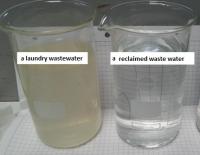Effective water and detergent recycling solution for industrial laundries
The concept proposed by a Polish-German consortium would offer savings and reduced pollution. On-board the REWARD project are scientists of the Warsaw University of Technology’s Faculty of Chemistry and Process Engineering.
“Industrial laundries use up to 10 liters of water and 6 grams of detergents per 1 kilogram of dry textiles,” says Maciej Szwast, D.Sc., Eng., who heads up the WUT team. “For laundries with a daily capacity of 15 tonnes of textiles (notably hotel and hospital bed linen, workwear, staff and hospital wear), the daily water consumption touches a whopping 150,000 liters and the detergent consumption (of washing, softening and bleaching preparations) is about 90 kilograms. Hence, a great volume of wastewater contaminated with those chemicals and with all that was on the washed textiles.”
Up to 15 times less
The Polish-German team wants to recover most of the water used in the washing process and, if possible, also part of laundry detergents. The recovered water could be returned to the washing process (at the pre-wash stage) and the recovered detergents could help bring down the quantity of new ones added to the next washing cycles.
“Certainly, this technology also produces a stream of wastewater, but it is already, says, 10 to 20 thousand liters a day rather than 150 thousand,” says Maciej Szwast, D.Sc., Eng. “This generates big savings on water for the site, a reduced wastewater discharge and, of course, a great benefit to the environment.”
A novelty
How does it work? The consortium members resolved to use an integrated process comprising membrane filtration and dipole induction.
“For membrane filtration, we use our proprietary micro-/ultrafiltration membranes; these are filtration materials (something like a sieve) with pores sized in the range of fractions (or hundredths) of a micrometer,” explains Maciej Szwast, D.Sc., Eng. “Water with dissolved compounds, including detergents, flows through such a membrane. But elements which are larger than the membrane pores (apertures), in particular solid particles of dirt as well as fats and proteins (notably those forming micelles with washing agents) are held back.”
The resulting filtrate can be reused in the washing process.
“Dipole induction is a method chiefly known in the metals industry,” explains Maciej Szwast, D.Sc., Eng. “Here, a specially designed electrode charges solid particles (in this case, these are textile fibers or particles of dirt) so that they would form larger aggregates for easier separation on the membrane.”
The WUT scientist hastes to say that membrane modules have been fitted in washers for a few years now. “But they are only intended to treat the water discharged to the sewer a bit,” he clarifies. “It seems, we are the first to have addressed the issue of closing the water flow in laundries for real.”
Proven in tests
Two real-world tests, i.e. on-site tests in an actual industrial laundry, have already been done in the project. Water (or wastewater to be precise) taken off after the main washing process was treated in a pilot facility equipped with a membrane module and a dipole electrode. It was then possible to reuse the water so treated in another washing cycle.
“Those tests demonstrated that our treatment method is effective,” says Maciej Szwast D.Sc., Eng. “Further tests run in accordance with the German standards for the laundry industry proved that the washing quality had not deteriorated when the recycled water was used compared to the washing quality obtained with fresh water.” In other words, the main project objective, i.e. the recovery of water, has been achieved.
Will the idea be put to market?
Currently, work is underway to reduce the quantity of laundry detergents added to subsequent washing cycles and to prepare economic analyses of the solution for the country-specific conditions prevailing in Poland and in Germany.
The objective of the REWARD project is to develop a technology and assess its economic merits. Implementation falls beyond the project scope. But the implementation is highly probable, largely owing to the experience and expertise that the consortium members can boast. And the members are, in addition to the Warsaw University of Technology, Polymemtech sp. z o.o. (a Poland-based manufacturer of membrane systems), Hollywood Textile Service (one of the major industrial laundries in Poland), Hochenstein Institute (a private research institute in Germany), ATEC (a Germany-based manufacturer of membrane systems) and AQON (a Germany-based manufacturer of industrial systems, including dipole induction systems).
The core of the team representing the WUT are Maciej Szwast, D.Sc., Eng., and Daniel Polak, M.Sc., Eng. A group of diploma students of the Faculty of Chemistry and Process Engineering are also involved in the work.
Agnieszka Kapela
Promotion and Information Office
Project duration: May 15, 2017 to April 15, 2020
The project “Development of a sustainable water and detergent recycling process for industrial laundries” is funded by the National Centre for Research and Development (NCBR) under the Polish-German Joint Research Call.
The project is funded by the European Union under the Polish-German Sustainability Research (“STAIR”) Programme run together with the German Federal Ministry of Education and Research (BMBF).








